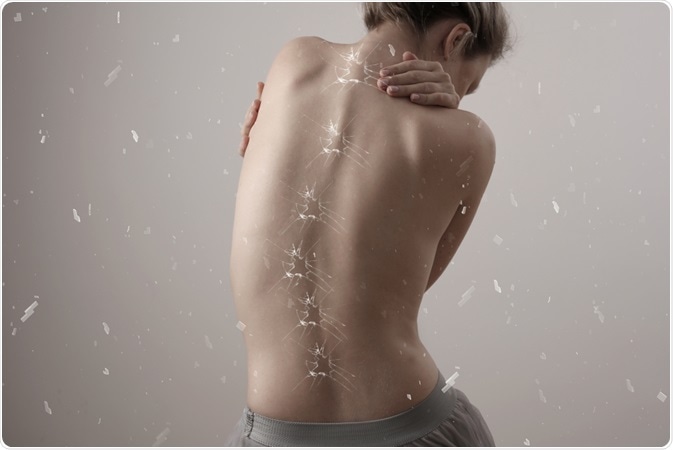Scoliosis is a health condition that involves the sideways curvature of the spine, usually resulting in an “S” or “C” shaped curve in the back that is evident on an X-ray.
The term is derived from the Greek word skoliosis, which means crooked, as a result of the altered shape of the spine that is characteristic of the condition.

Image Credit: Albina Gavrilovic / Shutterstock.com
Development
Scoliosis usually develops in children in the growth spurt prior to puberty, between the ages of 9 and 14. However, it can also be present from birth or arise due to related health conditions that affect the individual, such as cerebral palsy and muscular dystrophy.
Most individuals with scoliosis have mild effects that do not greatly impact their daily life and activities. However, in severe cases, the condition can have disabling effects, particularly if the spinal curvature inhibits the pulmonary cavity and the ability to breathe easily.
Children with scoliosis should be monitored closely as they grow to allow early intervention if the spinal curvature worsens. This is usually carried out with the use of X-rays to view the bone development. While many children will not need any treatment, some children will require a brace to prevent curvature worsening and others will need surgery to prevent or correct the curve.
Symptoms
Most children with scoliosis do not complain of any pain as a result of scoliosis. In the majority of cases, the initial sign of the disease is visual changes of the back and asymmetry of the body.
For adults with the disease, however, back pain can become a more prominent issue. The cosmetic view of the spine and back can also be worrying for some individuals and may lead to social anxiety and other mental health issues.
Classification
Scoliosis can be classified according to the likely cause and by the curvature of the spine.
The causes may include:
- Congenital: The vertebral anomalies arise at birth,
- Idiopathic: The cause is unknown and may have presented in infancy, childhood, adolescence, or adulthood
- Neuromuscular: Scoliosis is secondary to a related health condition such as spina bifida, cerebral palsy, spinal muscular atrophy, or other physical trauma.
The convexity or direction of the spinal column may be:
- Dextroscoliosis: Convexity of spine on the right side of the body
- Levoscoliosis: Convexity of spine on the left side of the body.
Management
There are three main methods of treatment of scoliosis, which include observation, bracing, and surgery.
In the initial stages of the disease, the best course of action is to use X-ray imaging every four to six months to view the changes in the spinal curvature. This is because many individuals will not need any intervention, but early initiation of treatment is beneficial for those who do.
A brace can be used to foster bone health and improve the straight growth of the spine. The brace should be worn at all times, except when showering or having a bath, which usually equates to at least 23 hours per day. Many children who use a cast will achieve sufficient support of their spine to prevent worsening of the curvature; however, some may still require corrective surgery.
Surgery is helpful to improve bone growth and correct severe spinal curves that may lead to cardiopulmonary complications. Growth rods can be inserted for younger children to guide the growth of the spine throughout childhood and adolescence. When the individual is done growing, at approximately the age of 17, corrective spinal fusion therapy can be carried out to straighten out the spine when the degree of curvature is significant.
References
Further Reading